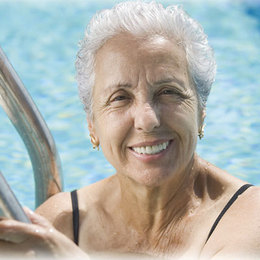
Aquatic therapy is quickly becoming well known for its benefits for decreasing pain, speeding recovery, preventing injury and improving function. Also known as pool therapy, aquatic therapy consists of an exercise program that is performed in the water.
It is useful for a variety of medical conditions because it uses the physical properties of water to assist in patient healing and exercise performance. In most cases, the fastest way to recover from pain or injury is to begin the rehabilitation process, but oftentimes pain levels may impact a patient’s ability to start. This is especially true for patients over the age of 60.
Aquatic therapy is administered in a specially designed, technologically advanced pool that complements traditional, land-based therapy programs. Water possesses unique properties such as buoyancy and viscosity, which help to extend the range of motion for people who have sustained physical injuries or have lost flexibility over time.
While submerged in water, buoyancy assists in supporting your weight, which is particularly important for patients with arthritis, fractured bones, chronic pain, or who are generally out of shape, says John Mishock, DC, DPT, MPT, who recently added an aquatic therapy pool in the Gilbertsville location of his Mishock Physical Therapy & Associates.
Sheree Troutman, an aquatic therapist of 11 years who current practices at Mishock’s facility in Gilbertsville, believes that since the water is forgiving and kind to the body, it can be especially beneficial to the elderly.
“I find that my older patients who view physical therapy with a negative stigma really end up loving the pool,” Troutman says. “They can exercise with vigor in the water without having to worry about the impact on their joints.”
The viscosity of water also provides an excellent source of resistance that can easily be incorporated into an aquatic therapy exercise program. This resistance allows for muscle strengthening without the need of weights.
Using this resistance allows a person to strengthen muscle groups with decreased joint stress that cannot be experienced on land, says William Gregory, DPT, CSCS, owner of Bucks Physical Therapy with an aquatic therapy pool at its Richboro location.
Aquatic therapy also utilizes hydrostatic pressure in decreasing joint and soft tissue swelling that result after injury or with arthritic disorders. This reduction in swelling reduces pain by decreasing pressure on soft tissue and nerves.
Troutman finds that her patients exercise with such ease in the water that they are rarely out of breath, and therefore still able to talk during the sessions and share their stories, which has become her favorite part of her job.
Finally, the warmth of the water experienced during aquatic therapy assists in relaxing muscles and opening up blood vessels, therefore increasing blood flow to injured areas. Patients with muscle spasms, back pain and fibromyalgia find this aspect of aquatic therapy especially therapeutic.
Mishock Physical Therapy & Associates
1806 Swamp Pike, Suite 100, Gilbertsville, 610-327-2600
MishockPT.com
Bucks Physical Therapy
100 Almshouse Road, Richboro
215-357-2000
BucksPhysicalTherapy.com
Danielle Wallace is a freelance writer in Montgomery County.


